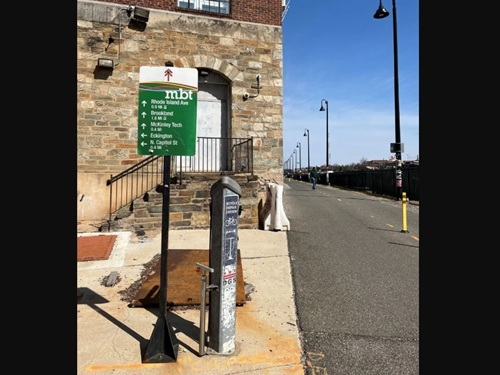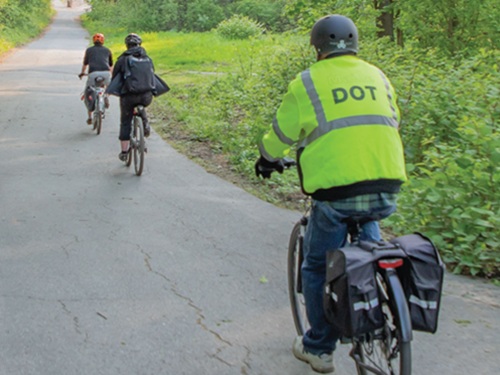The Maine Department of Transportation is filling the gap – literally – to help active transportation advocates complete a 16-mile multi-purpose trail for pedestrians and bicyclists in southern Maine.
[Above photo by the Maine DOT]
While this project involves just a 1.6-mile-long section of that trail, a series of barriers – a river, railroad tracks, the COVID-19 pandemic, easement issues, and a lack of funds – kept it on the shelf for more than a decade.
Now that Maine DOT has budgeted the lion’s share of the project with state and federal funds, construction is underway on the nearly $7 million project and is expected to be completed by November 2027.
When finished, the new trail will tie into existing trails that are part of southern Maine’s Eastern Trail and U.S. Bicycle Route 1. It also will become part of the East Coast Greenway; a 3,000-mile, 15-state route along a series of multi-use roads and trails from Maine to Florida.
In an interview with the Leaflet by AASHTO, Dakota Hewlett – a Maine DOT active transportation planner – said the department committed funds to the project because active transportation “is increasingly important” nationally and in Maine.
“Southern Maine communities are linked by our coastline, Route 1, and other roadways, and increasingly by the Eastern Trail,” he said.
Hewlett described the trail as “a spine route…from which people can access neighborhoods, jobs, public facilities, and many of the destinations these communities are known for.”
The project is being managed by the Town of Scarborough, but Maine DOT’s project manager is monitoring all work to ensure compliance with state and federal fiscal regulations, Hewlett said.
While Maine DOT brought the bulk of funding to the project, much of the pre-construction heavy lifting was done by the Town of Scarborough and the non-profit group Eastern Trail Alliance (ETA), Hewlett said. Those entities raised matching funds, undertook public outreach efforts, and kept the project alive.
Because of that prep work, the Maine DOT “can justify our involvement and magnify that planning work into infrastructure projects that make a positive impact for the public,” Hewlett said.
From the west, the new trail will cross the Nonesuch River, turn south, and cross a railroad track before turning northeast to a sports complex in South Portland. Two new active transportation bridges in in the Town of Scarborough – one to cross the river and another to cross the tracks – will be constructed toward the end of the project.
Chelsey Berlin, ETA’s executive director, said the vision of a continuous trail for walkers and bikers was the dream of “a long line of Mainers,” including ETA founder John Andrews, who worked on the project from the early 1990s until his death in 2017.
“Because of the efforts of John and others, we raised over $500,000 to go toward the project,” Berlin said, adding that this project means more to locals than just recreation.
“This is huge for multi-modal infrastructure in southern Maine,” Berlina noted. “People might use the trail now just to go to the store, get an ice cream cone in the summer, or go to work.”
Maine DOT’s Hewlett agreed. “Part of our multi-modal system includes facilities for bicycling and walking, and other human-scale modes of transportation,” he said.
“This project is an example of how over time Maine DOT and local governments can work together to connect a facility for bicycling and walking across an entire region of the state, providing a safe opportunity to connect multiple towns, neighborhoods, and destinations together,” Hewlett added.
 Active Transportation
Active Transportation



